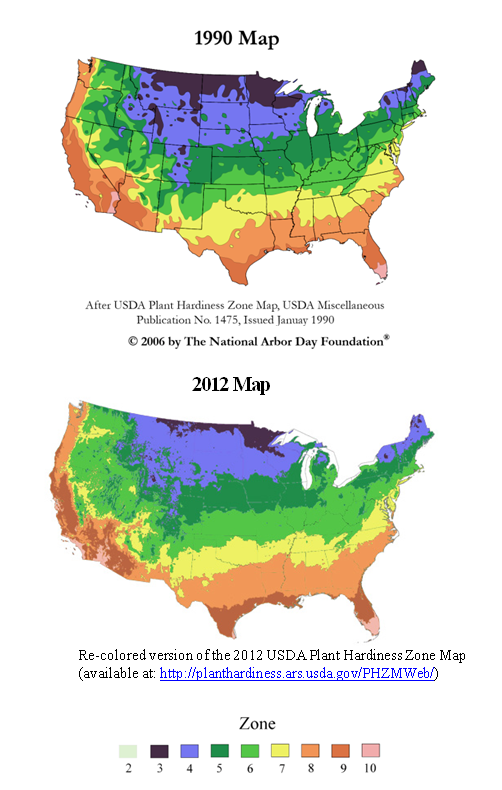The Growing Liability of Rental Property Mold
Attorney Larry Farber spoke at the March 8, 2018 meeting in Longmeadow about mold liability, and his talk remains the authoritative perspective. Moisture and associated mold are an increasing liability for landlords, especially where ice dams can weaken and destroy roofs and gutters, and climate change has increased our USDA hardiness zone by half a level, to a more mold-friendly climate. We consider the three kinds of mold cases and the implications for rental housing.

The Arbor Day Foundation shows that USDA hardiness zones have increased. This is contributing to changing flora and fauna in Massachusetts, including expanding the time each year mold can proliferate.
This article is a paraphrasing of the Attorney Farber talk not previously published. Any errors or omissions are MassLandlords’ own. Always consult with an attorney before taking action that could affect your rights.
What is Mold
Mold is a fungus that grows everywhere by eating natural material. This includes things that we would consider food, like old strawberries, as well as parts of buildings, like wood, drywall, and caulking. Mold spores are like pollen in the sense that they are everywhere.
In large enough quantities, and with certain species, people can have allergic or toxic reactions. The symptoms caused by mold allergy are the same as symptoms caused by all pollen allergies, including: watery, itchy eyes; a chronic cough; headaches or migraines; difficulty breathing; rashes; tiredness; sinus problems; nasal blockage and frequent sneezing. A mold toxicity is also possible, with more serious symptoms that may require medical attention.
Three Kinds of Mold Cases
Attorney Farber outlined the three most common types of cases in real estate: personal injury, conditions claims or counterclaims, and defective construction. Defective construction is ten times more frequently an issue than conditions claims, but this article will focus on conditions claims because those are the issues that affect landlords with existing housing stock.
Mold Personal Injury
The sanitary code says you can’t have excess moisture. It’s silent on mold. There’s a level of proof needed for any case, and the level of proof differs greatly for personal injury from mold compared to basic conditions claims related to the sanitary code, to be discussed below. Personal injury requires proving that the mold injured the renter.
First, the renter must test the premises and must know what type of mold it was. Second, the renter must be tested themselves and be known to have an allergy to the specific mold found in the premises, and for that mold to have been found in their system. Many people can claim an allergy, but only 15% to 25% will actual have an allergic reaction. Third, there must be a clear causal connection to how the mold you have in your building caused them harm (e.g., a defined and measured reaction). Fourth, there must be expert testimony in-person, otherwise it’s hearsay.
Note that you must have actual contact with mold for a long time to get sick. Personal injury has a much tougher standard, but also a much bigger payout, than other types of cases.
There was a case in 2016 that shows the difficulty of proving a mold injury, and the consequences of having one occur, South Boston Elderly Residences, Inc. vs Gerald Moynahan (91 MA App Court 455, 2016). Judge Winik examined two claims. First, that there was mold, and second, that there was an air quality issue because the windows didn’t open. The judge awarded basic sanitary code damages. The appeals court overturned this in favor of the higher personal injury standard.
The appeals court decision relied on two facts. First, under contract law, you have what’s called a “reasonable person” standard. But under tort law, you take your plaintiff as you find them, even if they are unreasonably sensitive. For instance, Attorney Farber shared a law school anecdote, where they talk about the “eggshell skull” example. There’s a car accident, the plaintiff hits his head and his skull shatters because he had a special condition that makes his skull unusually breakable. They are entitled to full damages even though they are more than normally sensitive to injury because that’s how torts work.
The appeals court said the mold in the Elderly Residence wasn’t a contractual issue, it was a tort. This is the case law that establishes mold sensitivity as a possible personal injury claim.
Breach of Warranty (Conditions Claims)
Breach of warranty is going to be more common for owners than personal injury.
Attorney Farber reminded us that there are three kinds of conditions claims. First, there can be a 93A consumer protection claim. Second, there can be a quiet enjoyment claim, which requires there to be negligence. Third, there can be a basic habitability claim, which doesn’t require negligence, doesn’t generally award attorney’s fees, and carries actual damages.
With quiet enjoyment you’re entitled to either actual damages or three times a month’s rent, plus attorney’s fees, plus emotional distress.
With 93A, which relates to unfair or deceptive acts, e.g., violating any law, you’re entitled to 2x or 3x actual damages plus attorney’s fees.
In a conditions claim, you only get the biggest of the three possible recoveries. For instance, you can’t get 93A and quiet enjoyment. A condition of mold may trigger one or more of these, depending on the facts, and the law is squishy.
Judge Robert Fields of the Western Division, where Attorney Farber practices, was used as an example. Most people come forward with mold in bathroom grout. Judge Fields doesn’t tend to give that weight unless it was caused by water leaks. Because you don’t know really whether it was the tenant’s housekeeping or the landlord’s inadequate fan or window venting. In most cases, grout mold doesn’t reach a level of “excessive moisture” for a claim. This is the first problem with conditions claims: “Who is really at fault here?”
There’s a secondary problem with conditions claims, and that is, tenants must prove that the mold inside exists at a greater level than the mold in the outside environment.
Note that basements and attics are a different matter from bathrooms. If you have a dehumidifier to control mold in these spaces, who pays for it? Who takes care of it? Attorney Farber said Judge Fields is clear on this being a landlord’s responsibility. The tenant is not allowed to be ordered to empty the bucket.
And note also that because the dehumidifier is required to meet code, you can’t put the electrical cost on the tenant’s meter. You will need an owner’s meter and an owner’s outlet in the basement. If you end up in this position, asked to pay for dehumidifier bills going back to the beginning of time, you may be able to appeal, but it will cost you $5,000 to $10,000 and a year just to try. Why risk it? The best advice is to set up an owner’s outlet and plumbing for the dehumidifier drain and forget about it.
With conditions claims, the worst-case scenario is usually three month’s rent. It usually doesn’t rise to the level of a breach of quiet enjoyment.
Note that tenants can be caught and blamed. For instance, if a tenant vented their dryer into the basement, clearly any mold problem there will be the tenant’s fault and the case can be dismissed.
Compared to the 6,000 eviction cases Western Division sees every year, Judge Dina Fein had about 2 mold cases, Judge Fields had about 14, according to Attorney Farber. These are miniscule odds and no cause for a careful landlord to lose sleep.
Additional Questions about Rental Property Mold
With regard to insurance, one-time exposure to water will be covered by insurance. Chronic moisture is always excluded. So depending on what event caused the mold, you may be able to get remediation paid for.
Unlike security deposits, mold has not been well defined in case law. One thing is certain though: Who removes the mold if the tenant caused it?
If the tenant creates the violation, sanitary code is clear, the landlord has to fix it. The landlord can then bring action against the tenant under the lease. This is where a lease shines, it will typically be enforceable for claims like this better than a month-to-month.
Make sure you always document what you’re doing. Take pictures. Record correspondence. You could be counterclaimed with retaliation if you take action to enforce a lease or repair costs after a renter notifies you there is mold.
Be careful where wall mold has taken root. You may need to remove the drywall or have a professional evaluate it for enzyme remediation. You may also want to put in a moisture sensor to monitor for recurrence. One member in the audience shared that they had installed a moisture sensor. They noticed 95% humidity every day at 4pm, and this led to a conversation about renter cooking habits that removed the cause of the mold growth.
Where does water get into the house? Typically, most landlords will want to check gutters and roof edges.
Note that Section 8 inspectors may be able to cite tenants for bathroom mold.
Note finally that unlike lead, mold is self-propagating, and can grow where you least expect it. It can even grow on dust. Just as you cannot delay responding to a pest control issue, you cannot delay responding to a mold issue, or your problem will grow ten or a hundred times worse.
Rental Property Mold Conclusion
The standards and payouts for a claim of personal injury due to mold are high, but the standards for a claim of conditions will still generate significant liability for some owners. As with all rental property considerations, it is important to maintain your rented premises and enforce compliance with rental agreement provisions, especially cleanliness. When presented with a claim about mold, work with your renters to resolve the issue outside of court, and always consult with an attorney.
Members can talk to experienced landlords about new enzyme-based mold remediation, which doesn't require drywall replacement.




